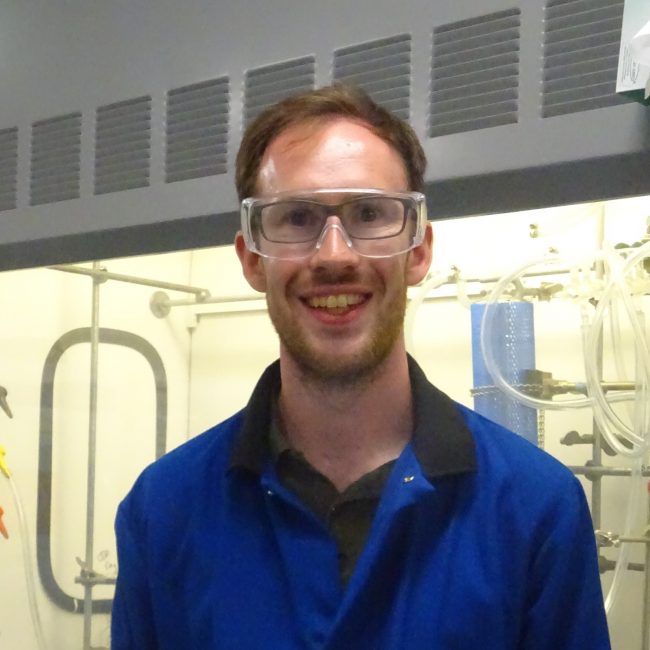Chris obtained his Masters Degree in Chemistry from the University of Oxford, UK in 2013, spending his final year thesis researching asymmetric bifunctional organocatalysis under the supervision of Prof. Darren Dixon. Later that year, he started his PhD at the University of Bristol, UK, where he was mentored by Prof. Varinder Aggarwal. His PhD was focused on developing new enantiospecific functionalization reactions of organoboron compounds. During his PhD, Chris had the opportunity to spend a few months living in Germany, working at the MPI für Kohlenforschung, Mülheim, and LMU, Munich. After obtaining his PhD in 2017, Chris moved to the University of Utah, USA, to work on electrocatalytic reaction methodologies with Prof. Matt Sigman. He will move to ICIQ in 2020 to work with Prof. Ruben Martin on the return leg of his global MSCA fellowship. Outside the lab, Chris can be found playing music, or going running and hiking in the mountains around Salt Lake City.
Dr. Christopher Sandford
Prof. Rubén Martín
The Combination of Electrochemistry and Nickel Catalysis: New Bond-Forming Reactions on a Sustainable Platform

ICIQ profile
From 01/05/2018 to
30/04/2021
ElectroNick - GA 789399
Sustainable routes towards the formation of key synthetic carbon–carbon bonds by cross-coupling remains a challenge in
organic chemistry. Realization of this goal will enable the combination of simple building blocks to rapidly assimilate synthetic
complexity with only a minimum level of stoichiometric waste. Electrochemistry provides a new platform to conduct reactions
through in situ generation of reactive intermediates under mild conditions, with broad applications to industrial synthesis.
Herein, we seek to combine the fields of electrochemistry and cross-coupling reactions, using an electric current to
catalytically generate alkylzinc reagents and reactive alkyl radicals. These intermediates will then undergo coupling,
facilitated by nickel catalysis, to generate key carbon–carbon bonds, including challenging C(sp3)–C(sp3) bonds.
Furthermore, the powerful combination of electrochemistry and nickel catalysis will enable the simplest feedstock chemicals
– alkanes – to be utilized for the first time in cross-coupling through a nickel chain-walking process, providing facile access to
fatty acids and alternative coupled products. These projects will enable the emergence of new reaction strategies for
exploitation in a sustainable manner. Additionally, this ambitious and innovative proposal will succeed through considerable
two-way transfer of knowledge between the participating organizations and the ER, developing the fellow into a leading
international researcher.
![]() This project has received funding from the European Union’s Horizon 2020 research and innovation program under grant agreement 789399
This project has received funding from the European Union’s Horizon 2020 research and innovation program under grant agreement 789399
Analyzing mechanisms in Co(I) redox catalysis using a pattern recognition platform
Tianhua Tang, Christopher Sandford, Shelley D. Minteer * and Matthew S. Sigman *
Chem. Sci. 2021, 12, 4771-4778
DOI: 10.1039/d0sc06725c
Mechanistic Studies into the Oxidative Addition of Co(I) Complexes: Combining Electroanalytical Techniques with Parameterization
C. Sandford, L. R. Fries, T. E. Ball, S. D. Minteer,* and M. S. Sigman
J. Am. Chem. Soc 2019, 141, 18877-18889
DOI: 10.1021/jacs.9b10771
A Synthetic Chemist’s Guide to Electroanalytical Tools for Studying Reaction Mechanisms
C. Sandford, M. A. Edwards, K. J. Klunder, D. P. Hickey, M. Li, K. Barman, M. S. Sigman, H. S. White, S. D. Minteer
Chem. Sci. 2019, 10, 6404–6422
DOI: 10.1039/C9SC01545K
Investigating the Role of Ligand Electronics on Stabilizing Electrocatalytically Relevant Low Valent Co(I) Intermediates
D. P. Hickey, C. Sandford, Z. Rhodes, T. Gensch, L. R.Fries, M. S. Sigman, S. D. Minteer
J. Am. Chem. Soc. 2019, 141, 1382-1392
DOI: 10.1021/jacs.8b12634
MSCA fellows at ICIQ – Video of Dr. Christopher Sandford
Christopher shares with us his experience as MSCA-IF global fellow at ICIQ
International Living as a Global MSCA Fellow
One of my favourite aspects of being a scientist is the ability to work with people from a wide variety of cultures. When I first got the opportunity to live